
In rail transport, a train is a series of connected vehicles that run along a railway track and transport people or freight. The word train comes from the Old French trahiner, derived from the Latin trahere meaning "to pull, to draw". Trains are typically pulled or pushed by locomotives, though some are self-propelled, such as multiple units. Passengers and cargo are carried in railroad cars, also known as wagons. Trains are designed to a certain gauge, or distance between rails. Most trains operate on steel tracks with steel wheels, the low friction of which makes them more efficient than other forms of transport.

A warning sign is a type of sign which indicates a potential hazard, obstacle, or condition requiring special attention. Some are traffic signs that indicate hazards on roads that may not be readily apparent to a driver.
Rail terminology is a form of technical terminology. The difference between the American term railroad and the international term railway is the most significant difference in rail terminology. There are also others, due to the parallel development of rail transport systems in different parts of the world.
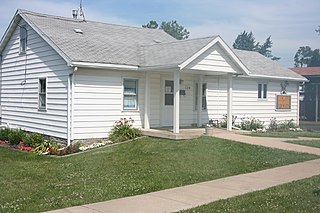
The Rochelle Railroad Park is a city park located in Rochelle, Illinois where railfans can safely view and photograph trains.
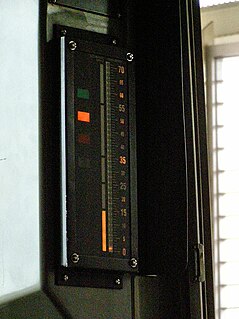
Cab signaling is a railway safety system that communicates track status and condition information to the cab, crew compartment or driver's compartment of a locomotive, railcar or multiple unit. The information is continually updated giving an easy to read display to the train driver or engine driver.
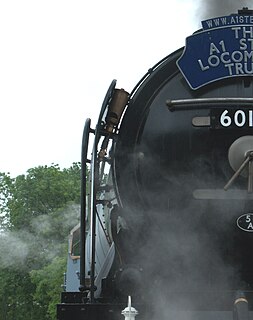
A train whistle or air whistle is an audible signaling device on a steam locomotive, used to warn that the train is approaching, and to communicate with rail workers. Modern diesel and electric locomotives primarily use a powerful air horn instead of a whistle as an audible warning device. However, the word whistle continues to be used by railroaders in referring to such signaling practices as "whistling off".

An air horn is a pneumatic device designed to create an extremely loud noise for signaling purposes. It usually consists of a source which produces compressed air, which passes into a horn through a reed or diaphragm. The stream of air causes the reed or diaphragm to vibrate, creating sound waves, then the horn amplifies the sound making it louder. Air horns are widely employed as vehicle horns, installed on large buses, semi-trailer trucks, fire trucks, trains, and some ambulances as a warning device, and on ships as a signaling device.
Automatic train stop or ATS is a system on a train that automatically stops a train if certain situations occur to prevent accidents. In some scenarios it functions as a type of dead man's switch. Automatic train stop differs from the concept of Automatic Train Control in that ATS usually does not feature an onboard speed control mechanism.
Safetran Systems Corporation was an American company that manufactured switch machines, railroad wayside signal systems, rail transit signaling and rail-highway level crossing active warning systems.
This article contains a list of terms, jargon, and slang used to varying degrees by railfans and railroad employees in the United States and Canada. Although not exhaustive, many of the entries in this list appear from time to time in specialist, rail-related publications. Inclusion of a term in this list does not necessarily imply its universal adoption by all railfans and railroad employees, and there may be significant regional variation in usage.

In rail transport, a whistle post or whistle board, is a sign marking a location where a train driver is required to sound the horn or whistle.
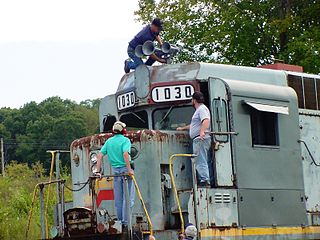
A train horn is an air horn that serves as an audible warning device on diesel and electric powered trains. The horn's primary purpose is to alert persons and animals to an oncoming train, especially when approaching a level crossing. They are often extremely loud, allowing them to be heard from a great distance. The horn is also used for acknowledging signals given by railroad employees, such as during switching operations. For steam locomotives, the equivalent device is a train whistle.

Positive train control (PTC) is a system of functional requirements for monitoring and controlling train movements and is a type of train protection system. The term stems from control engineering. The train is only allowed to move in case of positive movement allowance. It generally improves the safety of railway traffic.

Advanced Civil Speed Enforcement System (ACSES) is a positive train control cab signaling system developed by Alstom. The system is designed to prevent train-to-train collisions, protect against overspeed, and protect work crews with temporary speed restrictions. The information about permanent and temporary speed restrictions is transmitted to the train by transponders (Balises) lying in the track, coded track circuits and digital radio. It was installed beginning in 2000 on all of Amtrak's Northeast Corridor between Washington and Boston, and has been fully active since December 2015, a few months after the 2015 Philadelphia train derailment which it would have prevented.
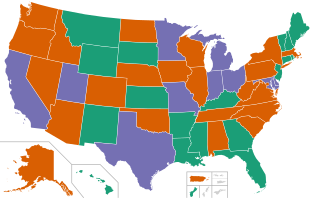
In the United States, road signs are, for the most part, standardized by federal regulations, most notably in the Manual on Uniform Traffic Control Devices (MUTCD) and its companion volume the Standard Highway Signs (SHS).

Pulse code cab signaling is a form of cab signaling technology developed in the United States by the Union Switch and Signal corporation for the Pennsylvania Railroad in the 1920s. The 4-aspect system widely adopted by the PRR and its successor railroads has become the dominant railroad cab signaling system in North America with versions of the technology also being adopted in Europe and rapid transit systems. In its home territory on former PRR successor Conrail owned lines and on railroads operating under the NORAC Rulebook it is known simply as Cab Signaling System or CSS.

The Southern California Railway Museum, formerly known as the Orange Empire Railway Museum, is a railroad museum in Perris, California, United States. It was founded in 1956 at Griffith Park in Los Angeles, before moving to the former Pinacate Station as the "Orange Empire Trolley Museum", in 1958. It was renamed "Orange Empire Railway Museum" in 1975 after merging with a museum then known as the California Southern Railroad Museum, and adopted its current name in 2019. The museum also operates a heritage railroad on the museum grounds.

Trains include a variety of types of lights, for safety, illumination, and communicating train status. The most universal type of light is the headlight, which is included on the front of locomotives, and frequently on the rear as well. Other types of lights include classification lights, which indicate train direction and status, and ditch lights, which are a pair of lights positioned towards the bottom of a train to illuminate the tracks.
Designs of level crossings, where railway lines cross roads or other paths, vary country-to-country.














